Manufacturer’s warranty period extended to two years
 |
| Trolex |
This manufacturer of gas detection and environmental monitoring systems has extended its warranty period to two years, providing additional coverage for all of its equipment. The company also offers a service contract specifically tailored to requirements that cover the maintenance of its products (photo). When customers call for product support, they speak directly to an engineer, not a call center. — Trolex Ltd., Stockport, Cheshire, U.K.
PID detects VOCs and up to four more hazards
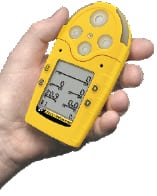 |
| Honeywell Process Solutions |
Rugged and durable, the GasAlertMicro 5 PID (photo) measures for photo-ionization detectable (PID) VOCs (volatile organic compounds), while simultaneously monitoring and displaying up to four additional atmospheric hazards, including oxygen, combustible gases and a range of toxic gases. The PID sensor adds photo-ionization detection capabilities. Compact and lightweight, with a concussion-proof, waterproof IP66/67-rated boot, it is well suited for harsh industrial environments. The portable gas detector provides multi-language support in English, French, German, Spanish and Portuguese and offers visual, audible and vibrating alarms. — Honeywell Process Solutions, Houston
Detector now approved for underground mining
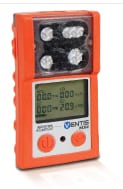 |
| Industrial Scientific |
The lightweight and highly configurable Ventis MX4 (photo) is capable of detecting from one to four gases, including oxygen (O2), methane (CH4) and any two of the following toxic gases: carbon monoxide (CO), hydrogen sulfide (H2S), nitrogen dioxide (NO2) and sulfur dioxide (SO2). The Ventis can be configured with CH4, CO, and O2 sensors for many everyday mining applications, or it can be configured with CH4, CO, O2 and NO2 sensors, making it ideal for mines using diesel equipment. In fact, the Ventis MX4 has recently received MSHA approval for underground mining. The Ventis without pump has been certified by MSHA under Title 30 CFR, Part 22 when used with the standard or extended runtime lithium-ion battery packs. The company anticipates that the Ventis with pump will receive MSHA approval later this year. — Industrial Scientific Corp., Pittsburgh, Pa.
www.indsci.com/ventis
Measure thousands of gases in the field
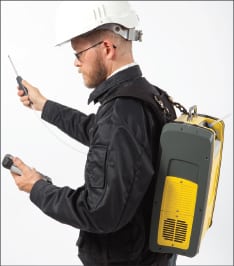 |
| Gasmet Technologies |
The DX4040 (photo) is the second generation of what is said to be the world’s first truly portable FTIR (Fourier transform infrared) spectroscopy analyzer, a technology that brought laboratory-grade gas analysis into the field. Up to 25 gases can be displayed simultaneously when operating the DX4040 with a handheld PDA. However, the most important development lies in the ability of the device to identify unknown gases in the field (at the touch of one button) when using a new version of the unit’s Calcmet software on a Windows tablet. The DX4040 is unique because it is able to identify both organic and inorganic compounds, while also storing sample spectra for post-measurement analysis using a chemical library of over 5,000 compounds. There are no sensors that might need future replacement. No sample preparation is required, and calibration is simply a zero check with nitrogen or air. — Gasmet Technologies Oy, Helsinki, Finland
O2 analyzer approved for hazardous-area use in North America
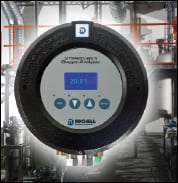 |
| Michell Instruments |
XTP601 Oxygen Analyzer (photo) has attained CSA certification, making it approved for use in hazardous areas in the U.S. and Canada. The instrument already carries certification from ATEX and IEC Ex, and the addition of CSA broadens its global coverage. The XTP601 uses thermo-paramagnetic measurement technology to make accurate and stable measurements of oxygen in background gases such as hydrogen, nitrogen and carbon dioxide. It is capable of measuring oxygen ranges from 0–1% up to 0–25%. Typical hazardous applications include monitoring of inerting or blanketing gases in petroleum refining, chemical and pharmaceutical industries. The analyzer, which is housed in a tough flame-proof and explosion-proof housing, is available in three versions: a blind transmitter; a unit with status LEDs or a full-display unit. This last version has a touch-screen interface, which allows through-the-glass interaction, eliminating the need to remove the analyzer lid (except for service). All versions are supplied with two 4–20-mA outputs, two concentration alarms Modbus RTU over RS485 protocol and application software as standard. — Michell Instruments, Ely, Cambridgeshire, U.K.
Fixed gas detector is protected against dust and water
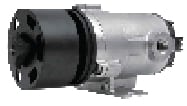 |
| Oldham Gas |
The OLCT IR infrared fixed gas detector (photo) has been tested according to IEC/EN 60529 and gets the IP67 protection degrees. As a result, the OLCT IR is totally protected against dust and against the effect of immersion in up to 1 m of water, putting the OLCT IR ahead of competitors’ products, says the manufacturer. With a stainless-steel 316L enclosure, dual source, four-beam technology, and heated optics the OLCT IR is said to be one of the most reliable infrared (IR) gas detectors on the market. A low-temperature version allows operation down to –50°C for the harshest industrial environment. The mean time between failures (MTBF) and the probability of failures on demand (PDF) both calculated by INERIS are respectively 28 years and 1,6  10–3 with a one-year interval test. — Oldham Gas, Pittsburgh, Pa.
CO2 detector protects against dangerous leaks
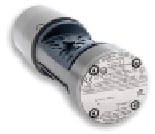 |
| General Monitors |
Offering reliable gas detection performance with low maintenance, the rugged Model IR700 Carbon Dioxide Point Detector (photo) requires no routine calibration and provides complete control room status and control capability for monitoring 0–5,000 ppm. The Model IR700 features a precision IR point-sensing element that offers reliable protection against the hazards of carbon-dioxide gas leaks. While CO2 is nonflammable, exposure to atmospheric concentrations above 5,000 ppm is considered unhealthy, making careful monitoring crucial at lower levels. The IR700 features a true fail-to-safe design for dependable gas detection performance, heated optics to eliminate condensation, and a dirty optics indicator informs the user the device must be cleaned before the lenses are entirely blocked, thereby reducing downtime. The Model IR700 IR detector features microprocessor-based technology to continuously monitor CO2. It features multiple communication outputs, a 4–20-mA signal, proportional to 0–100% full-scale, Modbus and HART. — General Monitors, Lake Forest, Calif.
Wireless communication improves installation and trending
Said to be an industry first, ELDS Version 1.2 Open Path Gas Detectors (OPGDs) feature Integrated 2.4 GHz Wireless Communications between the ELDS Transmitters/Receivers and the vendor’s installation and commissioning tools. The ELDS is easy to install, with 2.4 GHz wireless alignment and access to event logs, self check results, and system diagnostics. This eliminates hard-wired Class I Division I or II connectors and cables, or area de-classification for technician access to detectors via open junction box terminals for commissioning. ELDS Version 1.2 Wireless is particularly beneficial for OPGD systems installed high in the air or under floor grates. Version 1.2 also features expanded gas applications for high-level H2S detection at 0–15,000 ppm in FPSO Vent Gases, low-level ppm ammonia OPGD, low-level ppm HF OPGD for refinery alkylation processes, percent LEL HVAC OPGD cross-duct methane detection, and percent LEL cross-duct continuous methane monitoring for coal-bed combustion. — Senscient, Inc., League City, Tex.
Detect oxygen deficiency without high maintenance burdens
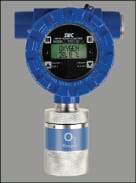 |
| Sierra Monitor |
The 4501-03, Oxygen Deficiency Gas Detector (photo) is a two-wire, loop-powered gas detector that boasts lower cost and easier installation and maintenance. This eliminates the need for separate power runs and associated power distribution and circuit protection for each device. Meanwhile, maintenance costs are low due to 4–20-mA, two-wire loop-powered design, a six-month calibration interval and the ability to calibrate without declassifying the area. — Sierra Monitor Corp., Milpitas, Calif.
Rebekkah Marshall